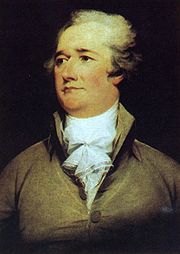
Federalist No. 9
Encyclopedia

Essay
An essay is a piece of writing which is often written from an author's personal point of view. Essays can consist of a number of elements, including: literary criticism, political manifestos, learned arguments, observations of daily life, recollections, and reflections of the author. The definition...
by Alexander Hamilton
Alexander Hamilton
Alexander Hamilton was a Founding Father, soldier, economist, political philosopher, one of America's first constitutional lawyers and the first United States Secretary of the Treasury...
and the ninth of the Federalist Papers
Federalist Papers
The Federalist Papers are a series of 85 articles or essays promoting the ratification of the United States Constitution. Seventy-seven of the essays were published serially in The Independent Journal and The New York Packet between October 1787 and August 1788...
. It was published on November 21, 1787 under the pseudonym
Pseudonym
A pseudonym is a name that a person assumes for a particular purpose and that differs from his or her original orthonym...
Publius, the name under which all the Federalist Papers were published. Federalist No. 9 is titled, "The Union as a Safeguard Against Domestic Faction and Insurrection." The same subject is continued in the subsequent paper by James Madison
James Madison
James Madison, Jr. was an American statesman and political theorist. He was the fourth President of the United States and is hailed as the “Father of the Constitution” for being the primary author of the United States Constitution and at first an opponent of, and then a key author of the United...
, Federalist No. 10
Federalist No. 10
Federalist No. 10 is an essay written by James Madison and the tenth of the Federalist Papers, a series arguing for the ratification of the United States Constitution. It was published on Friday, November 22, 1787, under the pseudonym Publius, the name under which all the Federalist Papers were...
.
Publius' argument
A major aspect of Federalist No. 9 is Hamilton's response to the common Anti-Federalist argument based on the theories of MontesquieuCharles de Secondat, baron de Montesquieu
Charles-Louis de Secondat, baron de La Brède et de Montesquieu , generally referred to as simply Montesquieu, was a French social commentator and political thinker who lived during the Enlightenment...
, who wrote famously in his The Spirit of the Laws
The Spirit of the Laws
The Spirit of the Laws is a treatise on political theory first published anonymously by Charles de Secondat, Baron de Montesquieu in 1748 with the help of Claudine Guérin de Tencin...
that "it is natural to a republic to have only a small territory, otherwise it cannot long subsist." The Anti-Federalist took his arguments to mean that the federal Union was bound to fail. Hamilton responded that if Montesquieu were taken literally, then since he was thinking of dimensions far smaller even than those of the states, the Americans would have to split themselves into "an infinity of little, jealous, clashing tumultuous commonwealths." More seriously, Hamilton contends that the confederated federal system described in the proposed Constitution would not suffer as Montesquieu predicted because of its confederated, rather than centralized, design.

